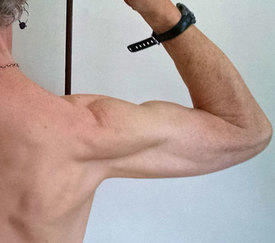Do you use your extra calories

from your workouts? I turned mine off for now to see how it goes. Don’t use them
Replies
-
sometimes eat a few back, but not all. Smart move trying it out to see what works best for you!
1 -
I've generally eaten all of my carefully estimated exercise calories, all through about a year of losing from class 1 obese to a healthy weight, then 9+ years of maintaining a healthy weight since.
4 -
It depends in part on how many calories you are burning from your exercise and how many calories you're eating. Half an hour of yoga, it doesn't matter. That's only 50 calories or so. An hour of running, then it is good to eat back most of the calories or you'll be hungry and may binge or give up on weight loss entirely. If your calorie goal is fairly low, then I would eat back as many exercise calories as possible to keep me on track. You don't want your net calories to get below 1200 if female or 1500 if male.
FWIW, like PTAnn, I eat back every calorie I burn. I have maintained a 50+ lb. weight loss for 10 years or so.
2 -
Yeah, it is a bit of trial and error for some people. There are so many ways we can screw up calorie numbers and exercise calories is but one way.
I always left them turned on, used all of them and lost weight just fine: not too fast and not too slowly. I lost 80ish pounds in 2007-08 and I've kept it off. It takes a few weeks of logging to see how you do. There are a lot of variables with weight loss numbers.
3 -
Some, but not all. I will usually use up some of them for pre- and post-workout fueling. On long run days, I might also add 100 calories or so to my meals so I'm not starving. As a rule, though, this doesn't usually equal to amount I've burned.
1 -
No harm in trying that to see if you lose better…. some swear by not eating them..others eat them all and swear by that.
bottom line.. we are all different and by trying different strategies you could stumble upon something that really works for you.
Best of luck. I hope it does work.
2 -
eating back calories is a slippery slope as most people underestimate weekly calorie intake and overestimate calories burned by exercise. That combo is a recipe for not making progress.
if you're super accurate with both it can work.2 -
Exactly this. Justine Ercole said it really well in a video when she said the problem with tracking exercise calories is that it's highly inaccurate and just one more way to overcomplicate calorie counting and one more way to make big counting mistakes and end up eating a lot more calories than you should be. Unless, of course, you're a marathon runner or work out 4 hours a day. If you do that, I'm not talking about you.
2 -
Nah, workably close is fine. Super accurate isn't essential.
Also fine:
- Averaging exercise plans into the base calorie estimate, as long as the person follows through with the exercise plan
- Setting a very moderate weight loss rate, doing relatively small amounts of exercise (half an hour 3 times a week or similar), and letting the exercise calorie burn increase the weight loss rate to moderate plus a little
What's not so fine:
- Setting up for a very aggressive weight loss rate, adding intense or lengthy near-daily exercise on top of that without fueling the exercise adequately
- Including exercise plans in base calorie goal via activity level settings, then eating exercise calories on top of that (double counting)
- Picking the highest exercise calorie estimates a person can find, and eating those on top of a planned very small deficit
Eating exercise calories or not eating exercise calories: It's just a difference in accounting method. Either one can work, in the abstract.
What really, really, doesn't work is not understanding the accounting method you personally choose, and through ignorance about how it works, either wiping out the calorie deficit (or a big chunk of it) or losing weight ultra-aggressively fast (because that increases chances of giving up due to misery, or having negative health consequences).
The choice between eating exercise calories back or not eating them back sometimes seems like it's treated as an article of religious faith around here, or as one size fits all. It's not that deep. It's just an accounting method choice, just arithmetic.
To me, the big prize here is not losing weight, it's staying at a healthy weight long term. There are myriad ways of doing that, too.
For me, with near daily fairly intense exercise a lot of the time, but main exercise modes that are weather dependent and seasonal, adding carefully-estimated exercise calories works great for me. On top of that, realistically, periodically I'm going to have multiple weeks at a time where I can't exercise, at least not at the same level, maybe not at all. (I'm talking illness, injury, surgical recovery.)
I've chosen to keep calorie counting in maintenance, and I'm now in year 9+ at a healthy weight. Knowing how to eat when I can't exercise has been helpful knowledge.
Those things won't apply to everyone. That's fine.
Both accounting methods can work, as long as a person understands their chosen method and applies it accordingly.
5 -
averaging exercise plans is basically just going more with a Tdee counting method which if your weekly exercise is somewhat consistent is going to be the safest way to not over complicte things and run the risk of being less accurate overall. If we're to be anecdotal with things, that is my method.
0 -
Mine is:
Take Fitbit calories out as given.
If connected to MFP, that's 100% of exercise calories because that's how Fitbit updates MFPs TDEE. This is only valid when seen the NEXT day at 00:01 am---it is not correct and final during the day
Take my logging as consistent and never empty or missed, therefore correct.
Take weight trend as independent arbiter.
Make a correction as to how much of Fitbit is fictitious (or under represented) based on weight results.
The 1%, 2%, 5%, 10% or whatever it is correction applies to the COMPLETE TDEE, not just the exercise calories.
So if Fitbit underestimates me by 10% on a total of 2000 or 2500 Cal of TDEE the correction is -200 or -250 for the day probably adjusted by changing my goal, and not 10% of the exercise calories.
Has worked fairly well for me from early days with meticulous logging where Fitbit was at less than 1% divergence to even these days 11 years later when it is closer to 10% and I log food in a different app...🤷🏼♀️
3 -
I eat most of my exercise calories, otherwise I'd consistently be eating under 1200 cals a day. I look at the weekly averages on the app though, as some days I may not eat them all but on some days I eat more calories than I've burned. It worked when I was losing weight and it's still working now.
3 -
Everyone is different. I used to have a lower IN target and ate back my exercise calories. I found I wasn’t making consistent progress. Earlier this year, I changed my MFP profile to ‘active’ and turned off exercise adjustment. It hasn’t been long enough to make a definitive conclusion, but so far I believe my body prefers the consistent calories IN.
You will need to figure out what works for you.1 -
It depends on what kind of exercise calories you’re talking about, as others have said.
I typically record 500-1000 per day exercise calories. What I find for myself is, days I’m working out a lot, I’m not typically that hungry and seldom eat them back. But days I’m lower end, I am hungry and do eat most of them.
What helps me is to drill down to the 7-day view and look at net calories, which is a seven day average taking into account my regular daily goal, plus any exercise calories I have earned versus what I’ve eaten and recorded in my diary. I have a certain net weekly goal, and as long as I’m close to that, I’m fine. I don’t sweat the daily calories.
Data is your friend. Log and learn. Your body is always in flux and it’s your responsibility to identify trends and learn from them to preserve your health and mobility.
You’ll find fascinating tidbits. I spent last week on the west coast visiting family. I ate at or above goal most days, but did no exercise, few steps, and, frustratingly, spent most the visit napping because I picked up a bug on the plane (?) over.
I averaged about 800 net calories per day above normal all last week.
Weighed in upon returning and was up several pounds. Less than a day later I was at my lowest weight in months, down5.4 pounds.
Yesterday, I was still feeling the effects and left 1200+ calories on the table before hitting the sack. Yep. Weight up a couple of pounds this morning. But because I recognize from following my data, I’m not worried.
I’m also going to make a point to eat above average today, because yesterday was so ridiculously low cal.
Is this nit picky? Yes, but it’s also calming, reassuring, and gives me a baseline to know what’s a good daily net average for me, including all the exercise.
Build yourself that data base, and learn from it. MFP has some great tools in that “nutrition” tab at the very bottom (on the iOS app, anyway) of the food diary page.
4 -
MFP has some great tools in that “nutrition” tab at the very bottom (on the iOS app, anyway) of the food diary page.
I don't use iOS, but on the web version of MFP there is a "Reports" in the navigation bar at the top on the Home page or from the FOOD diary that has a lot of good info, too. Reports is graphs of past food, exercise, nutrition, weight, etc. Goes back 90 days on the free version, probably at least a year on the paid Premium version.
1
Categories
- All Categories
- 1.4M Health, Wellness and Goals
- 398.2K Introduce Yourself
- 44.7K Getting Started
- 261K Health and Weight Loss
- 176.4K Food and Nutrition
- 47.7K Recipes
- 233K Fitness and Exercise
- 463 Sleep, Mindfulness and Overall Wellness
- 6.5K Goal: Maintaining Weight
- 8.7K Goal: Gaining Weight and Body Building
- 153.5K Motivation and Support
- 8.4K Challenges
- 1.4K Debate Club
- 96.5K Chit-Chat
- 2.6K Fun and Games
- 4.8K MyFitnessPal Information
- 13 News and Announcements
- 21 MyFitnessPal Academy
- 1.6K Feature Suggestions and Ideas
- 3.2K MyFitnessPal Tech Support Questions









